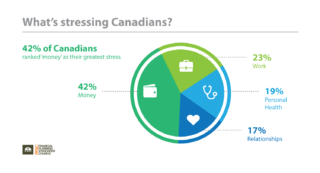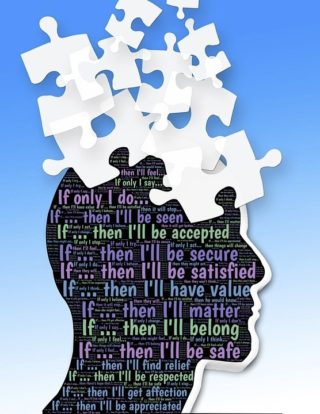res·o·lu·tion
noun; a firm decision to do or not to do something.
That time of year when our use of the word RESOLUTION tends to skyrocket is just around the corner. As a new year approaches, we often naturally find ourselves thinking about what goals we would like to set for ourselves in the upcoming year. We make promises to ourselves, and perhaps also to our friends or family, about what we plan to do differently, what we plan to start, and what we plan to stop. Creating New Year’s Resolutions can be a great way to not only make plans or set commitments for the upcoming year, but also to reflect on the past year.

Although it may sound like a simple task, many of us struggle with it. Some of us may feel that we cannot narrow down our list and may feel overwhelmed by the number of things we would like to accomplish, while others may feel that they cannot think of anything they would like to start, stop or change in the New Year. Even for those of us that have a clear idea of what we would like to achieve, we may find ourselves doubting whether we can actually do it, or whether we actually will.
We would like to provide you all with some useful steps to follow when setting your New Year’s Resolutions this year. These strategies will help you to narrow down what you value in life and set commitments in accordance with those values.
STEP 1: REFLECT MINDFULLY
First and foremost, take some time to reflect on the past year. Take out a blank piece of paper and answer the following questions:
- What did you accomplish this past year that you are proud of?
Remember, this is something that YOU are proud of accomplishing and not only something from which you received recognition from others. What is important is not the size of the accomplishment or the reward of that accomplishment, but rather that it was an accomplishment at all.
Accomplishments may not always provide pleasure or reward and they may not always be recognized by others as accomplishments, and that’s okay. For example, if you had been avoiding asking someone out on a date, but then did it, even if they rejected your invitation and left you feeling let down and embarrassed, you may still consider the act of asking the person out an accomplishment.
- What were you grateful for this past year?
Thinking about what you are grateful for can highlight areas of life that are important to you. It can identify people or things that you value and cherish, which can act as foundations upon which you set goals for the future. For example, if you identify that you are grateful for your job and the lifestyle it allows you to live, you may be more inclined to set New Year’s Resolutions that help you to grow within your job or further develop your skills for your job. Whereas if you find yourself noticing that you are not grateful for your job at all, perhaps that realization will allow you to set resolutions for change in that area of your life.
- On a scale of 0 to 10 (0 = not at all, and 10 = completely), how connected did you feel within each of the domains listed below over the past year?
If any of these domains are not at all important to you, feel free to skip them, however, if you hold any value in the domain, reflect on how connected you were in that area of your life this past year. Also, feel free to add your own domains if you think of one that is not listed here and is important to you.
Family relationships
Intimate relationships
Friendship
Work
Health
Spirituality
Community involvement
Leisure
Personal growth
See if you can identify some domains that were lacking compared to others this past year, and perhaps that will help you to set New Year’s Resolutions targeted to improve that domain in the upcoming year.
STEP 2: IDENTIFY VALUES
Once you have finished reflecting on the past year, use the information you gathered to identify who and what is important to you. This will help you later on when you are ready to set some resolutions because you will be able to recognize who and what you want to move towards in the New Year. For example, if you noticed that you were proud of your accomplishment of asking someone out on a date, you were grateful for your friends who supported you when you were turned down, yet you were still feeling disconnected in the intimate relationship domain of life, perhaps you can use this information to set a resolution that will help you move towards becoming more connected in that domain despite the disappointment you had endured in the past year. It is a New Year, a perfect time to try again, and it is always worth it if it is something that really matters to you.
STEP 3: SET S.M.A.R.T. RESOUTIONS
Setting New Year’s resolutions, in more generic terms, is goal setting. Some of you may have heard of SMART goals in goal setting. Making your goals SMART increase the likelihood that you will be successful in achieving them. It allows you to structure them in such a way that they almost feel that they can be held in your hands as an object rather than feeling like they are floating somewhere in the clouds.
** In brackets I added some substitute words that I found on Project Smart which I felt are also relevant to the objective of SMART goals, and particularly in setting New Year’s Resolutions (https://www.projectsmart.co.uk/smart-goals.php).
S – Specific (Significant)
Make sure each resolution that you set is clear to you and that it is specific enough that you would be able to explain it to someone else in just one sentence leaving as few unknowns left as possible. See if you can answer who, what, where, when, why, and how for each goal you set. For example, saying that your goal for the New Year is to be healthier is not a specific goal, whereas saying that your goal is to be healthier by exercising four days a week for at least 30 minutes and eating at least one serving of fruits and vegetables a day IS a specific goal.
M – Measurable (Meaningful, Motivational)
Make sure that you are able to measure your progress with your goal. Are you able to identify when you are moving towards that goal or away from that goal? For example, are you able to measure if you are being healthier if you don’t have anything to reference that goal with? What does ‘healthier’ mean to you? A measurable goal would be like the example above of exercising 4 times per week for at least 30 minutes – you would easily be able to measure whether you had done this or not.
A – Achievable (Attainable, Adaptive, Action-oriented)
Make sure that you have the means to achieve your goal. Are there barriers to achieving your goal that are completely out of your control? If you are setting a New Year’s Resolution that has the time-frame of one year, is this goal achievable in that time-frame? For example, if your goal is to become a doctor, is it possible to complete all the necessary education and training to do that in just one year? This does not mean that you should not set resolutions that will take longer than a year, but perhaps the end goal needs to be broken down into smaller, more achievable goals. For example, if becoming a doctor is your end goal, then perhaps your New Year’s Resolution could be to have all your medical school applications submitted by the end of the year.
R – Relevant (Realistic, Reasonable)
Make sure to check in with your values to identify whether the goals you are setting are actually relevant to YOU. Do not set your goals based on what other people want you to do (unless your underlying reasoning is because it is important to you to make that person happy), and do not set goals based on things you feel you should do. For example, if you set a goal to attend Church weekly solely because your family is very religious and want you to attend Church regularly, is this goal truly relevant to YOU?
T – Time-based (Trackable)
Make sure your goal has a target date. With New Year’s Resolutions, this target date is usually sometime within the year, but the more specific you can get with your time-frame, the better! You can ask yourself questions like: What can I do this week? What can I do in the next month? What can I do in 6 months? And so on, that may help you move towards a long term goal.
A new year provides opportunity to reflect on the past year and plan for the year to come. We understand and can appreciate first hand that setting New Year’s Resolutions can seem like a daunting or overwhelming task, but we hope that the strategies above help you to identify what is important you through mindful reflection and set goals that are in line with what you value.
From all of us at OHS, we wish you a very Happy New Year full of values guided living!
![]()


 get back to work, primarily because this notion and conditioned belief that their symptoms and work cannot co-exist has been carved into their minds. The earlier clients are referred to us, the better results we see. If we see clients at the point that they go off work, or even when they are still working but are having challenges, we can work with them to learn how to manage and cope with their difficulties in such a way that they do not have to give up a pivotal part of their life. We can provide strategies to manage their difficulties while AT WORK, and can teach them how to address and deal with issues as they arise. Furthermore, we can help them identify the value that their work brings to their life. Even if someone does not go into work every day thinking I LOVE MY JOB, we can often still help them identify what it is about working that is meaningful to them – whether it is financial security, status, sense of accomplishment, financial contribution within the family, setting an example for their children, the ability to live a comfortable lifestyle, or the means to keep their family healthy – there is rarely an empty response. From there, the client may notice that in being off work, they are moving away from that value rather than towards it, which is causing additional suffering to their already quite full plate of difficulties.
get back to work, primarily because this notion and conditioned belief that their symptoms and work cannot co-exist has been carved into their minds. The earlier clients are referred to us, the better results we see. If we see clients at the point that they go off work, or even when they are still working but are having challenges, we can work with them to learn how to manage and cope with their difficulties in such a way that they do not have to give up a pivotal part of their life. We can provide strategies to manage their difficulties while AT WORK, and can teach them how to address and deal with issues as they arise. Furthermore, we can help them identify the value that their work brings to their life. Even if someone does not go into work every day thinking I LOVE MY JOB, we can often still help them identify what it is about working that is meaningful to them – whether it is financial security, status, sense of accomplishment, financial contribution within the family, setting an example for their children, the ability to live a comfortable lifestyle, or the means to keep their family healthy – there is rarely an empty response. From there, the client may notice that in being off work, they are moving away from that value rather than towards it, which is causing additional suffering to their already quite full plate of difficulties.





 Our mind can be quite selfish, although its intentions may be good. When it perceives a threat, it goes into protection mode, as described in the examples above, and it does not often think beyond that. Although this helps us immensely in many of our interactions with the external world, it is when it tries to protect us from experiencing our uncontrollable internal content that it can make us feel, or act, defeated. Our internal content consists of our thoughts, feelings, and emotions. For example, if we struggle with social anxiety, our mind may instinctively try to protect us by encouraging us to avoid feeling this anxiety, which may only be achieved by avoiding any social interactions altogether. If we struggle with chronic pain, our mind may try to help us limit this pain (since it has learned to perceive pain as a threat) by encouraging us to avoid any type of physical activity or movement that may (but more likely will not) cause harm or damage. When faced with difficult internal content, our mind starts to create rules, stipulations, and limitations, which are often statements with BUT’S and IF and THEN’s that we are all very familiar with.
Our mind can be quite selfish, although its intentions may be good. When it perceives a threat, it goes into protection mode, as described in the examples above, and it does not often think beyond that. Although this helps us immensely in many of our interactions with the external world, it is when it tries to protect us from experiencing our uncontrollable internal content that it can make us feel, or act, defeated. Our internal content consists of our thoughts, feelings, and emotions. For example, if we struggle with social anxiety, our mind may instinctively try to protect us by encouraging us to avoid feeling this anxiety, which may only be achieved by avoiding any social interactions altogether. If we struggle with chronic pain, our mind may try to help us limit this pain (since it has learned to perceive pain as a threat) by encouraging us to avoid any type of physical activity or movement that may (but more likely will not) cause harm or damage. When faced with difficult internal content, our mind starts to create rules, stipulations, and limitations, which are often statements with BUT’S and IF and THEN’s that we are all very familiar with.
 TRY THIS…
TRY THIS… 
 If we do not TALK to one another and open up, we are left to rely only on our observations or our assumptions of those around us, rather than truly knowing them. For example, we may assume that if we do not observe any physical limitations or restrictions, then an individual does not have a disability; we may assume that if an individual dresses, sounds and appears of male gender, that he/she is truly of the male gender; that if an individual is always smiling and laughing, that they are truly happy; or that if an individual is always surrounded by people and has a big family, that they have a strong social support network. The problem here is that these are all assumptions and they can often be wrong. That person that is always smiling may be hiding their suffering behind a smile, or that person surrounded by family may feel completely alone in the world. This is why we need to TALK.
If we do not TALK to one another and open up, we are left to rely only on our observations or our assumptions of those around us, rather than truly knowing them. For example, we may assume that if we do not observe any physical limitations or restrictions, then an individual does not have a disability; we may assume that if an individual dresses, sounds and appears of male gender, that he/she is truly of the male gender; that if an individual is always smiling and laughing, that they are truly happy; or that if an individual is always surrounded by people and has a big family, that they have a strong social support network. The problem here is that these are all assumptions and they can often be wrong. That person that is always smiling may be hiding their suffering behind a smile, or that person surrounded by family may feel completely alone in the world. This is why we need to TALK.